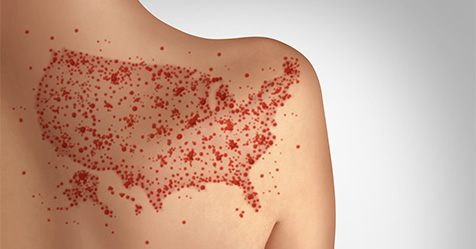Taking Steps to Prevent Norovirus Outbreaks
The highly contagious virus can be spread via infected persons, contaminated food or water, or contaminated surfaces.
According to the U.S. Centers for Disease Control and Prevention (CDC), based on data from 14 states participating in its Norovirus Sentinel Testing and Tracking (NoroSTAT) program, norovirus outbreaks are on the rise this season compared to last year.
During August 1, 2022–January 8, 2023, there were 225 norovirus outbreaks reported by NoroSTAT-participating states. During the same period last seasonal year, there were 172 norovirus outbreaks reported by these states.
Norovirus is commonly referred to as the stomach flu. However, it is not related to the influenza virus. Noroviruses are highly contagious and can be spread via infected persons, contaminated food or water, or contaminated surfaces. Symptoms typically include diarrhea, vomiting, nausea, and stomach pain, and sometimes fever, headaches, and body aches, due to inflammation of the stomach or intestines (acute gastroenteritis). A dangerous situation is the dehydration caused by the diarrhea and vomiting.
The most recent U.S. outbreak was in December 2022, when eight Southern states were affected by norovirus illnesses that investigators believe were linked to raw oysters from Texas.
“Everyone needs to remember that norovirus is a highly contagious virus that spreads via person to person and by coming into contact with contaminated surfaces or food—it only takes a few virus particles to make someone sick, and a sick person sheds billions of particles of the virus in their vomit and feces,” said Dr. Chip Manuel, Ph.D., food safety science advisor at GOJO Industries. “Part of the reason why it’s the No. 1 cause of foodborne illness in the U.S. is also that it can survive on surfaces for weeks. So even if COVID-19 goes away tomorrow, surface and hand hygiene remain a critical piece to foodborne illness prevention, particularly norovirus—and particularly for foodservice establishments where one sick worker can spread norovirus throughout an establishment, including through the food they touch.”
These following steps from GOJO can help facilities with in-house food establishments prevent a norovirus outbreak:
- Keep sick employees home. According to the CDC, 70% of norovirus outbreaks are caused by infected foodservice workers. Employees that come to work sick spread the virus to foods, surfaces, customers, and other employees.
- Practice frequent proper hand hygiene and minimize bare-hand contact with food. Ensure bare-hand contact with foods is minimized by emphasizing proper glove use. Providing handwashing stations and encourage frequent handwashing are critical hand hygiene practices.
- Disinfect high-touch surfaces regularly. Disinfect high-touch surfaces since they have a direct carryover to controlling foodborne illnesses, especially norovirus. Examples include frequent disinfection of restroom door handles, sink faucet handles, and restroom stall latches.
- Clean before you sanitize. Proper surface sanitizing requires the surface to be cleaned first to remove all food debris, fats, oils, and other soils. This ensures that the sanitizer solution will remain effective.
- Ditch the “rag and bucket” practice. Using a red bucket of sanitizing solution and a reusable cloth is a common way to sanitize tables in food establishment. But reusable cloths can easily become breeding grounds for foodborne disease-causing bacteria. Switching to applying a food-contact sanitizer by spray bottle or a disposable wipe can reduce some of the risks associated with reusable cloths.
- Select an effective surface product with low toxicity that works quickly. By using ready-to-use products with short contact times (e.g., a minute or less), compliance with enhanced disinfection protocols will increase, which helps reduce the risk of an outbreak within a facility—plus it saves your staff valuable time.
“Norovirus outbreaks are costly. They put the health of customers and employees at risk, can significantly damage a restaurant’s reputation, and with labor shortages, operators likely can’t afford to have employees out sick,” Dr. Manuel said. “Cases typically peak in January or February, so there is time for establishments to act now and prepare.”
To learn more about norovirus and its prevention, check out ’Tis the Season…for Norovirus.


